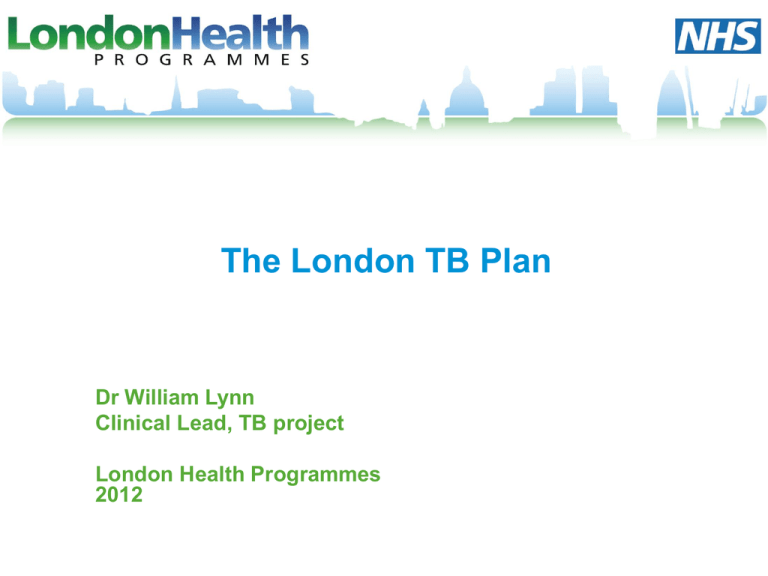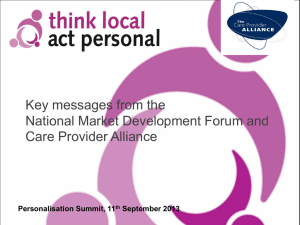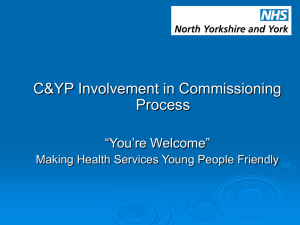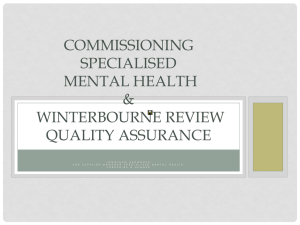120125_Presentation_GP Council-3
advertisement

The London TB Plan Dr William Lynn Clinical Lead, TB project London Health Programmes 2012 Overview • In 2010 there were 3,302 new cases of TB in the capital, the highest of any major city in Western Europe • London Health Programmes and the TB community have developed both a case for change and a model of care; a compelling set of arguments for the need improve the care for people with TB in London and a plan to reduce the number of new cases • The cluster Chief Executives are currently reviewing this model, which aims to begin implementation from April 2012 2 TB rates in Western European capital cities, 2009 3 Development of the plan • The case for change and model of care has been developed by the TB community including nurses, consultants, GPs, the Health Protection Agency and TB networks • Overseen by both a clinical working group and project board with strong public health expertise and service user representation 4 Engagement • Extensive eight week engagement period on both the draft case for change and model of care • Stakeholder events along with meetings, national and public media, 1:1 interviews • Over 200 individuals provided feedback including GPs, patients, voluntary and community organisations, public health and government committees • There was widespread support for the plans 5 Case for Change - TB in London • TB is an infectious disease that is treatable and curable however remains a major public health issue • The number of TB cases has increased by 50% over the last ten years and more than doubled over the last 20 years • In 2010 there were more cases of new TB cases diagnosed in the capital than HIV cases • TB rates vary widely across the capital 6 TB rates by Primary Care Trust of residence, 2010 Enfield Barnet Harrow Waltham Forest Haringey Redbridge Havering Hillingdon Brent City & Hackney Camden Barking & Dagenham Islington Tower Hamlets Westminster Ealing Kensington & Chelsea Southwark Greenwich Hammersmith & Fulham Hounslow Newham Lambeth Richmond & Twickenham Bexley Wandsworth Lewisham TB rate /100,000 population Kingston Sutton & Merton Bromley Croydon ? 80 60 -79 40 -59 20 -39 <20 Source: London Regional Epidemiologist, HPA 7 TB rates in London, 1982-2010 8 Key issues for TB Latent TB Active transmission 80% of active cases are from latent TB, activated years after the patient has become infected More prevalent in social risk groups including drug and alcohol users, homelessness, prisoners and people with mental health issues No systematic screening – majority identified only when disease reactivates Poor treatment completion rates lead to high rates of drug resistant TB which is costly and time consuming for the patient and NHS Prophylactic treatment can be unpleasant and lengthy. Patients from high risk groups often present late, resulting in complications and onward transmission of the disease to others 9 Treatment • Treatment comprises anti-TB drugs for at least six months • Treatment carries risk of unpleasant side effects • Treatment completion essential - but often not finished • Development of drug resistant TB means using more specialist anti-TB drugs with more side effects and worse outcome • Greater cost to the system 10 Treatment completion rates by PCT, 2010 95% 90% 85% 80% 75% 70% North Central North East North West South East South West 11 Finance • Estimated total spend on TB c.£25m Category Definition Cost Uncomplicated Patient identified early with prompt diagnosis, drug £1,100 sensitive TB requiring a six month course of (lowest treatment. May include brief inpatient spell or self amount) managed isolation Complex Treatment not complete - patient has increased risk of developing drug resistant TB and a lengthy hospital inpatient stay £10,000 (usually exceeds) Exceptional Extensive inpatient stay, treatment and follow up care – mortality is high and may require lifelong care and support. A handful of these cases present each year £100,000 (often exceeds) 12 Current service provision • 5 TB networks across London with variability in commissioning, service planning, protocols and education • Service resources, capacity and delivery does not align with TB rates • Poor awareness of TB among health professionals • Uptake and administration of neonatal vaccination is variable 13 Case for Change • The case for change highlights the risks for London if these problems are not addressed: – – – – Further fragmentation in services Poor and varied quality of care for patients Increased rates of active, latent and drug resistant TB Greater cost to the system for TB services and treatment for patients A model of care was therefore developed that sets out how to address the TB problem in London using a “multistranded solution to a multi-faceted problem” 14 Model of Care • Recommendations in the model are targeted at three aspects of the patient pathway: – Early detection and diagnosis of the disease – Better coordinated commissioning – Addressing variability of provision 15 Improving detection and diagnosis Person has TB symptoms Model of Care Increased awareness of TB in high-risk communities (section 4.1) Person enters UK from high-incidence country Port Health service screens high-risk person and identifies potential TB infection Patient identified by other service - Find & Treat, prison health and other clinical specialists Person presents at GP surgery, A&E department or other urgent care centre TB suspected and patient referred to TB service Increased awareness and knowledge of TB among healthcare professionals (section 4.2) TB screening programme to detect active and latent TB (section 4.3) Named Case Manager allocated Diagnostic investigations by TB service Improving commissioning London Commissioning Board ensures the proactive, robust commissioning of services (section 5.1) Patient diagnosed with TB Contact tracing & screening Medically complex TB is commissioned from specialist TB centres (section 5.2) Find and Treat support treatment completion (section 5.3) Central accommodation fund for homeless TB patients (section 5.4) HPU referral where appropriate Treatment Patient followed up and reviewed Treatment completed Improving services Delivery Boards ensure a coordinated, seamless approach (section 6.1) London risk assessment, DOT and cohort review protocols are mandated in NHS contracts (section 6.2) Workforce Development Group reviews capacity and capability of teams to deliver the model of care (section 6.3) Patient discharged 16 Improving detection and diagnosis • Raise awareness in communities with higher rates of TB disease • Raise awareness in health and social care workers • Pan-London active and latent TB case finding focusing on new registrations in primary care - piloted in NW London for first year 17 Improving the commissioning of TB services • Develop a London TB Commissioning Board to address current system fragmentation • The board would bring together the functions of health care commissioning, health protection and public health to ensure a co-ordinated, multi-agency approach to TB control • Robust commissioning of TB services will include sound planning, standard setting and strong performance management 18 Improving the commissioning of TB services • Continue to commission the Find and Treat service to work with hard to reach groups in the community • Establish a central accommodation fund for patients with no recourse to public funds • Ensure three levels of service provision • Level 1 - Generic primary and community care • Level 2 - Recognised TB services • Level 3 - Specialist TB services 19 Variability of service provision • Five local delivery boards established to act as a single providers of TB services - mirror current networks to maintain strong clinical relationships and referral patterns • Delivery boards will ensure standardised pathways and protocols are developed to promote consistent, high quality care for patients • Workforce development group will ensure appropriate skill mix and best value for money is achieved. 20 Finance Considerations – cost Year one (pan-London) Awareness raising programme Establish London Commissioning Board £150,000 £250,000 (Redeploy existing LHP resource) Find and Treat £816,000 (already agreed for 12/13) Central accommodation budget Total £100,000 £1.32m Of which £250K is not already in system 21 Finance Considerations – cost Year one – NW London only Costs of IGRA tests for case finding programme Cost of LES or equivalent for case finding programme Additional treatment costs (prophylactic and active) Total £253,000 £51,000 £1.4m £1.704m Of which £304K would be up-front investment and £1.4m would be additional activity in acute contracts 22 Finance Considerations – cost Annual costs from year two (pan-London) Awareness raising programme Costs of IGRA tests for case finding programme Cost of LES or equivalent for case finding programme Support to London Commissioning Board Find and Treat Central accommodation budget Sub-total £150,000 £890,000 £177,000 £250,000 £816,000 £100,000 £2,383,000 Additional treatment costs (prophylactic and active) £5,089,000 (Decreasing year on year) 23 Costs by cluster from 2013 Total cost Already in system New investment NCL £1,206,901 £175,247 £1,031,653 NEL £1,806,733 £225,375 £1,581,358 NWL £2,069,476 £257,943 £1,811,533 SEL £1,400,585 £220,680 £1,179,905 SWL £988,435 £186,755 £801,680 Total £7,472,130 £1,066,000 £6,406,130 Note – additional treatment costs will reduce year on year. Savings will exceed new investment from 2016/17. 24 Financial considerations – savings • Without intervention, costs of treatment are expected to rise over the next 10 years – savings resulting from the case finding programme alone will exceed the cost of the do nothing approach by 2016/17. • The majority of savings are achieved through avoided treatment costs both as a result of a reduction in onward infection and an overall reduction in TB incidence. • Further savings will be achieved through awareness raising programmes and pan-London protocol implementation. 25 Financial considerations – savings Cost of TB Treatment Case Finding vs. Do Nothing £ Millions 25 20 15 2012 2013 2014 2015 2016 Net TB costs - with case finding 2017 2018 2019 2020 2021 Net TB costs - do nothing 26 Next steps The GP Council is asked to: • Endorse the case for change • Support the recommendation to cluster chief executives that implementation of the model begins in 2012/13 • Consider a progress report later in 2012 to inform future decision-making 27 Further information • Full versions of the case for change and model of care documents (not yet in the public domain) are available from http://www.londonhp.nhs.uk/publications/tuberculosis/working/ • Additional information (published) is available from http://www.londonhp.nhs.uk/publications/tuberculosis/ 28






